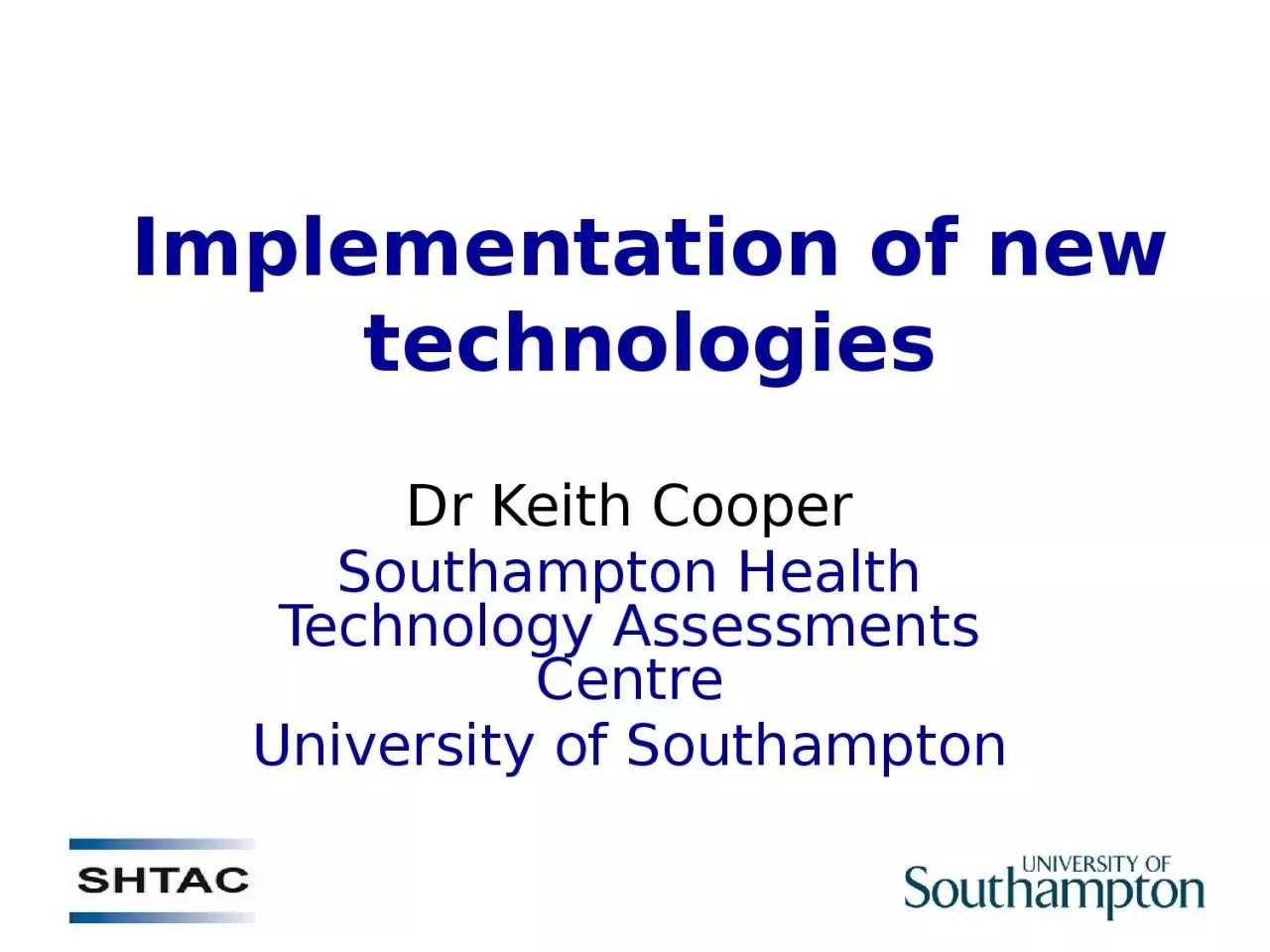

Dr Keith Cooper Southampton Health Technology Assessments Centre University of Southampton Structure of talk Introduction Background to evidence based decision making for implementing new technologies ID: 916194
Download Presentation The PPT/PDF document "Implementation of new technologies" is the property of its rightful owner. Permission is granted to download and print the materials on this web site for personal, non-commercial use only, and to display it on your personal computer provided you do not modify the materials and that you retain all copyright notices contained in the materials. By downloading content from our website, you accept the terms of this agreement.
Slide1
Implementation of new technologies
Dr Keith CooperSouthampton Health Technology Assessments CentreUniversity of Southampton
Slide2Structure of talkIntroductionBackground to evidence based decision making for implementing new technologies
Example: Machine perfusion preservation vs. cold storage in kidney transplantation
Slide3IntroductionWithin health care systems there is limited resources and increasing demand on services
Choices need to be made in a fair and equitable manner
Choice B
Choice A
Slide4HTA modelling
Health Technology Assessment aims to evaluate health technologies by investigating:whether the technology works for whom at what cost how it compares with the alternativesA health technology can be any intervention that improves health and includes
medications, devices, hospital procedures, health promotion activities and diagnostic testsHealth Technology Assessment in the UK is overseen by the NIHR HTA programme Provides Technology Assessment Reports for NICE
Slide5NICE (National Institute for Health and Clinical Excellence)
Provides guidance to NHS on new technologies, promote clinical excellence and the effective use of resources within the NHS. Recommendations are based upon Clinical evidence: systematic review, meta analysesEconomic evidence: cost effectiveness modelsBases decision-making on Technology Assessment Reports (TARs) and manufacturer submissions
TARs produced by university departments, such as Southampton Health Technology Assessments Centre (SHTAC)New technologies are most often more effective and more costly – is it good value for money to adopt?
Slide6NICE decision making – Cost effectiveness
Costs and health benefits are estimated for patients on alternative treatmentsHealth benefits are in term of Quality Adjusted Life YearsLife expectancy + Quality of lifeCompare new treatment with existing treatment(s)NICE is more likely to recommend a treatment if its cost effectiveness is lower than CE threshold (£30,000 per QALY)
Slide7Machine perfusion systems and cold static storage of kidneys from deceased donors
NICE technology appraisal guidance [TA165] Published date: January 2009Assessment group report by PenTAG, university of Exeter(Bond, Pitt, Akoh, Moxham, Hoyle, Anderson)
Slide8What is the best method of preservation for kidneys for transplantation?
Cold storage solutionsthe kidney is flushed through with a sterile preservation solution and is kept on ice in a box before transplantationMarshall's hypertonic citrate (Soltran, Baxter Healthcare) and Belzer UW (Viaspan, Bristol Myers Squibb)Machine perfusion systemsMachine perfusion systems continuously pump cold preservation solution through the kidneyThe LifePortTM kidney transporter (Organ Recovery Systems), RM3 renal preservation system (Waters Medical Systems)
Slide9Clinical evidence
Machine Preservation Trial (Moers, 2008)PPART study (Watson 2010)
Cold storage (Viaspan)N= 336Machine perfusion (Lifeport
)N = 336Cold storageN = 45Machine perfusion (Lifeport
)
N = 45
Proportion of delayed
graft function following transplant
26.5%
20.8%
56%
58%
Proportion of primary
non function
4.8%
2.1%
0%
2%
Graft survival at 1 year
90%
94%
98%
93.3%
Slide10Cost effectiveness model
Slide11Other model parameters (costs)
Parameter Value
Storage cost per Kidney:Cold storage (ViaSpan)
£262.33
Machine perfusion (LifePort)
£736.55
Other
costs
Transplant cost
£16,413
Dialysis cost (per month)
£2052
Post transplant
cost (month 1-3)
£2463
Post transplant cost (month 4-12)
£1385
Slide12Other model parameters (QALY)
Quality of life values (age 50 years)Transplant state: 0.75Dialysis state: 0.63
Slide13Cost effectiveness results
Results using MPT data (Moers 2008)Costs per patientHealth benefits (QALYs)Preferred technology
Cold storage (ViaSpan)£142,8059.58Machine
perfusion (LifePort)£139,1109.79
Difference
£-3695
0.22
Machine perfusion
Results using PPART data (Watson
2010)
Costs per patient
Health
benefits (QALYs)
Preferred technology
Cold storage (ViaSpan)
£139,205
9.19
Machine
perfusion (
LifePort
)
£141,319
9.13
Difference
£2114
-0.06
Cold storage
Slide14NICE recommendations
The overall costs and benefits associated with kidney transplantation using either machine perfusion or cold static storage were similar. The Committee recommended that the LifePort kidney transporter be considered as an alternative to cold static storage solutions. The choice of which to use would depend on clinical and logistical factors within both the retrieval team and transplant centres.
Slide15NICE – recommendations further research
The Committee considered that it was important for transplant centres to collect standardised and comprehensive data that follow up the outcomes for kidneys stored using different methods.
Slide16ConclusionsUnclear from current data (2009), whether machine perfusion preferable to cold storage
Depends upon trial data usedDifficult to show difference in clinical outcomesLarge RCT is needed which may not be practicalOther more recent studies have come to different conclusionsGomez et al 2012 – MP is cost effectiveGroen et al 2012 – MP cost savingJochmans 2015 (Transplant International) provides excellent overview of current evidence
Slide17Thank you!